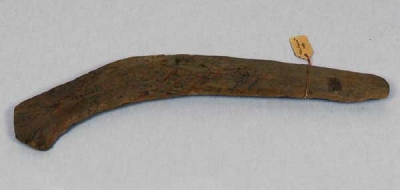Ancient toy throwing stick (1890.26.17)
 EgyptAncient toy throwing stick from Egypt, Africa. Found by William Matthew Flinders Petrie during excavations at Lahun in 1890. Given to the Museum by Henry Martyn Kennard in 1890.
EgyptAncient toy throwing stick from Egypt, Africa. Found by William Matthew Flinders Petrie during excavations at Lahun in 1890. Given to the Museum by Henry Martyn Kennard in 1890.
Flattened throwing sticks or clubs exhibiting some, albeit rudimentary, aerodynamic features have been found from prehistoric Europe, Ancient Egypt, the Sudan, India and Arizona. From papyri and tomb inscriptions we know that the Ancient Egyptians used large, sickle-shaped sticks for hunting fowl in the Nile marshes and perhaps also in warfare.
This example, however, is very small, only 28 cm long, and bears traces of decoration of red chevrons interspersed with black dots. It was probably a child's toy, dating from 1897-1778 BC, the second half of the XIIth (12th) Dynasty of the Middle Kingdom. It was discovered by the pioneering Egyptologist, Sir William Flinders Petrie during his excavations at Kahun (El Lahun) in 1888-1890.
A Place in History
This miniature throwing stick was excavated from the ancient Egyptian site of Kahun by Egyptology's founding father, William Flinders Petrie. Kahun was a name coined by Petrie himself after mishearing the name of the nearest modern village, El Lahun. It is located in the Fayoum, a fertile depression 50km south of Cairo. Petrie chose this excavation site because it included the stepped pyramid of Illahun (El Lahun) and an associated town site. Previous excavations in Egypt had revelealed soemthing of the life of the pharaohs, but Kahun was the first dig to reveal the daily life of the common Ancient Egyptian people. The pyramid was that of the fourth XIIth Dynasty king, Senwosret II (reigned 1897-1878 BC). In order to build his pyramid, he ordered a large workforce to be amassed, so the settlement was built to house them. It was occupied for no more than 100 years, and so we can securely date this toy throwing stick to some time in the 130 years between 1897 and 1778 BC.
Petrie began excavation at the site in 1888, and returned for a number of excavation seasons until 1920. However, since this example was acquired from H. M. Kennard in 1890, we can be sure this artefact was excavated during the first season. During this season, Petrie and his team concentrated their efforts in Kahun's 'Western Quarter', and so again, we can be sure the throwing stick was excavated in that area. This 'Western Quarter' is characterised by smaller back-to-back terraced housing (Ranks A through F). Consequently, we can see this as the toy of an ordinary Ancient Egyptian child.
Petrie relied on private benefactors for his excavation funding, particularly Jesse Haworth and Kennard, whom he remunerated with antiquities. Roughly 25% of the Kahun artefacts went to each of these two men, while Petrie kept 50% for himself. His share went on to form a major part of UCL's Petrie Museum of Egyptology. Clearly, Kennard gave this piece to the Pitt Rivers Museum.
Additional resources
The Petrie Museum has an excellent online catalogue, with colour photos of other Kahun boomerangs. However, these are full-size and they do not have a toy one such as this. To visit the catalogue, click here
The Petrie Museum have also collaborated with the University of Manchester, who hold a significant part of the Kahun material, to create Virtual Kahun, a site which allows you to learn more about the excavations, the people involved, and what was uncovered. To visit the site, click here




